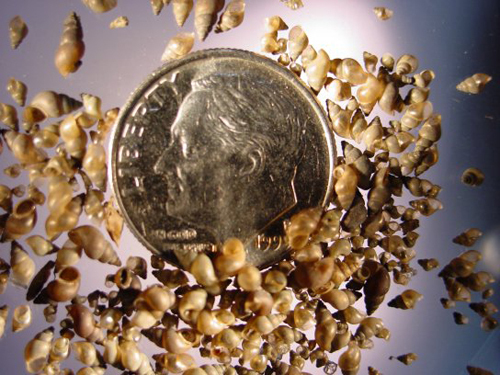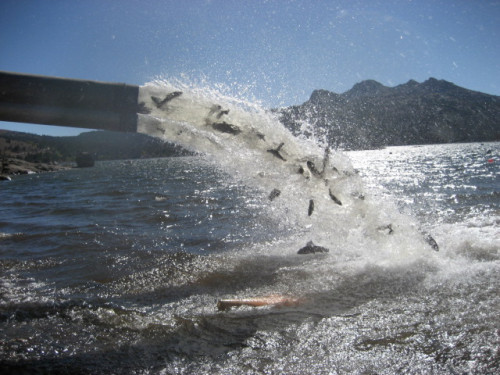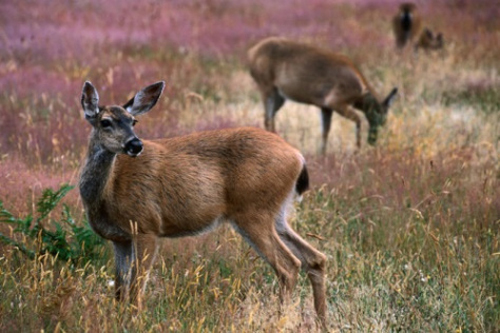Eastern Sierra Fish Report
Yuba River Fish Report for 2-19-2016
Yuba River Fish Report for 2-19-2016
Invasive Mudsnails Detected in Yuba River
Yuba River

by California Department of Fish & Wildlife
2-19-2016
Website
The California Department of Fish and Wildlife (CDFW) has confirmed the presence of New Zealand mudsnails in the Yuba River in both Yuba and Nevada counties. The snails have been detected at the Sycamore Ranch Park and Campground and at locations on the lower Yuba River both above and below the Highway 20 bridge crossing.
CDFW biologists confirmed the presence of snails at these locations just one week after discovering a new population in the lower Feather River. They were already known to be present in many other California lakes and river systems, including the Owens, Klamath, Russian, Lower American, Stanislaus, Merced, San Joaquin and Sacramento rivers and many of their tributaries.
"We don't have any way to confirm that the Yuba River population originated with the Feather River population, but it's possible," CDFW Senior Environmental Scientist Colin Purdy said. "New Zealand mudsnails are notorious for hitchhiking on waders and fishing gear. It's critical that anyone who uses infested waters for recreational purposes be extremely vigilant about checking for snails. The more they spread, the bigger the threat to our native fish populations."
New Zealand mudsnails are tiny, aquatic snails that reach, on average, up to 4-6 millimeters long. Dense populations of New Zealand mudsnails can displace and out-compete native species, sometimes by consuming up to half the food resources in the waterway. The snails have been linked to reduced populations of aquatic insects, including mayflies, stoneflies, caddisflies, chironomids and other insect groups upon which trout and salmon populations depend.
Boaters, anglers and others who may visit the Yuba or lower Feather rivers are asked to decontaminate equipment and follow the "clean, drain and dry" directive with all equipment used in the river:
If you wade, freeze waders and other gear overnight (at least six hours).
After leaving the water, inspect waders, boots, float tubes, boats and trailers or any gear used in the water. Remove any visible snails with a stiff brush and follow with rinsing. If possible, freeze or completely dry out any wet gear.
Never transport live fish or other aquatic plants or animals from one waterbody to another.
CDFW biologists are in the process of conducting additional sampling in adjacent waterbodies including Englebright Reservoir, New Bullards Bar Reservoir and in upstream reaches of the Yuba River in order to better define the geographic range of this new population. Target sampling areas will include high traffic areas, boat launches, access points and side channels.
To date, New Zealand mudsnails have not been identified in Englebright Reservoir or at locations of the Yuba River upstream of Englebright Reservoir.
In the coming weeks, CDFW will implement public outreach and education efforts, including information cards, brochures and signage posted at parks, campgrounds, marinas (Englebright and New Bullards Bar), bait shops and boat launches along the Yuba River and at various access points and wildlife areas.
CDFW biologists confirmed the presence of snails at these locations just one week after discovering a new population in the lower Feather River. They were already known to be present in many other California lakes and river systems, including the Owens, Klamath, Russian, Lower American, Stanislaus, Merced, San Joaquin and Sacramento rivers and many of their tributaries.
"We don't have any way to confirm that the Yuba River population originated with the Feather River population, but it's possible," CDFW Senior Environmental Scientist Colin Purdy said. "New Zealand mudsnails are notorious for hitchhiking on waders and fishing gear. It's critical that anyone who uses infested waters for recreational purposes be extremely vigilant about checking for snails. The more they spread, the bigger the threat to our native fish populations."
New Zealand mudsnails are tiny, aquatic snails that reach, on average, up to 4-6 millimeters long. Dense populations of New Zealand mudsnails can displace and out-compete native species, sometimes by consuming up to half the food resources in the waterway. The snails have been linked to reduced populations of aquatic insects, including mayflies, stoneflies, caddisflies, chironomids and other insect groups upon which trout and salmon populations depend.
Boaters, anglers and others who may visit the Yuba or lower Feather rivers are asked to decontaminate equipment and follow the "clean, drain and dry" directive with all equipment used in the river:
If you wade, freeze waders and other gear overnight (at least six hours).
After leaving the water, inspect waders, boots, float tubes, boats and trailers or any gear used in the water. Remove any visible snails with a stiff brush and follow with rinsing. If possible, freeze or completely dry out any wet gear.
Never transport live fish or other aquatic plants or animals from one waterbody to another.
CDFW biologists are in the process of conducting additional sampling in adjacent waterbodies including Englebright Reservoir, New Bullards Bar Reservoir and in upstream reaches of the Yuba River in order to better define the geographic range of this new population. Target sampling areas will include high traffic areas, boat launches, access points and side channels.
To date, New Zealand mudsnails have not been identified in Englebright Reservoir or at locations of the Yuba River upstream of Englebright Reservoir.
In the coming weeks, CDFW will implement public outreach and education efforts, including information cards, brochures and signage posted at parks, campgrounds, marinas (Englebright and New Bullards Bar), bait shops and boat launches along the Yuba River and at various access points and wildlife areas.
< Previous Report Next Report >
< Previous Report Next Report >
More Reports

2-18-2016
The CDFW has posted it's trout planting schedule for the week of February 14, 2016. Alameda County - Shadow Cliff Lake Contra...... Read More

2-17-2016
California’s key wildlife conservation planning tool, the State Wildlife Action Plan (SWAP), has received final approval from the U.S. Fish...... Read More

www.EasternSierraFishReports.com © 2024. All Rights Reserved.
Website Hosting and Design provided by TECK.net
Website Hosting and Design provided by TECK.net